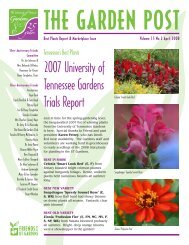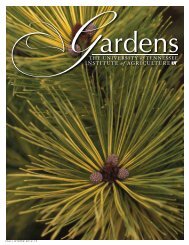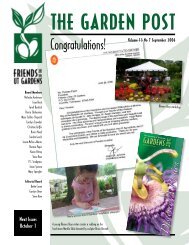May - UT Gardens - The University of Tennessee
May - UT Gardens - The University of Tennessee
May - UT Gardens - The University of Tennessee
You also want an ePaper? Increase the reach of your titles
YUMPU automatically turns print PDFs into web optimized ePapers that Google loves.
<strong>May</strong> Gardening TipsBecause <strong>May</strong> is one <strong>of</strong> the busiest times <strong>of</strong> thegardening season, it’s important to keep somesafety tips in mind:• Before beginning strenuous work, take amoment to stretch and loosen up your muscles.Remember it’s harder on your body to plant andweed a garden than to look at pretty pictures <strong>of</strong>them in a catalog.• Apply sunscreen <strong>of</strong>ten and evenly, even oncloudy or cool days.• Wear knee pads or use a foam knee support, oran old folded blanket or towel.• Drink plenty <strong>of</strong> water.• Lift with your knees not with your back.• Know your limitations. Take more but lighterloaded trips to the compost or mulch pile.• Sharpen, repair or replace hoes, pruners andmower blades, which will take less effort to useand be safer.—James Newburn, <strong>UT</strong> <strong>Gardens</strong> curator<strong>UT</strong> <strong>Gardens</strong>’ Plant Pr<strong>of</strong>ileBotanical Name: Paeonia hybridsCommon Name: PeonyThis fragrant big-bloomed perennial is said to benamed after Paeon, the pre-Apollonian physician<strong>of</strong> the Greek gods. Also known as a blessed herb,peonies have been used medicinally for centuries;in China it was known as the healing plant. Paeonymasculata the “masculine” peony, was used greatlyin medieval England, particularly in monasterygardens. Feminine, medicinal and most commonlyused today, came Paeony <strong>of</strong>ficianalis, in 1548. <strong>The</strong>first “Chinese” peony arrived at Kew (Royal Botanic<strong>Gardens</strong>) in 1784. Thanks to American settlers, weare able to enjoy the peony’s beauty and charmyear after year in our <strong>Tennessee</strong> gardens.Peony Angel CheeksPeonies look great in perennial borders and serveeffectively as a boastful cut-flower. It is an easy andreliable perennial to grow that can live 100 yearsor more if undisturbed. Peonies do not need to befertilized or divided. <strong>The</strong> only maintenance chorerequired is cutting old foliage back to the groundonce it turns yellow and starts to die. Plants grow toabout 3 feet tall and wide with a round growth habit.Having ants on your peonies is common and not aproblem. Ants are attracted to the sweet juice <strong>of</strong> abud about to open. <strong>The</strong>y do no damage and are gonewhen the bud opens. Place plants in full-sun to lightshade,and in deep, fertile, well-drained soil, where itcan really shine. Plant no more than 2 inches belowthe soil surface, away from competing roots, andprotected from late spring freezes.Different perhaps from what your mother or grandmotherused to grow, new colored cultivars are availableincluding corals, reds, and yellows. <strong>The</strong>y arebeing bred for greater blight resistance and morecompact forms to avoid bowing blooms. Favoritesconsist <strong>of</strong> a double pale pink ‘Sarah Bernhardt,’‘Coral Charm,’ ‘Vivid Rose,’ and a yellow ‘Build MeUp Buttercup.’ Dr. Steven Still, a herbaceous ornamentalplant guru and author, suggests checking outthe American Peony Society for further informationon this voluptuous aromatic perennial. Peonies atthe <strong>UT</strong> <strong>Gardens</strong> can be found in the perennial borderin beds Nos. 12 and 13. Peonies and peony trees areavailable at Stanley’s Greenhouses, Dixie Lee GardenCenter, Meadow View Nursery and Pope’s.—Jennifer Resig, student intern











